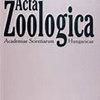Ecology of the cold-adapted species Nebria germari (Coleoptera: Carabidae): the role of supraglacial stony debris as refugium during the current interglacial period
IF 0.8
4区 生物学
Q4 ZOOLOGY
Acta Zoologica Academiae Scientiarum Hungaricae
Pub Date : 2020-11-08
DOI:10.17109/azh.66.suppl.199.2020
引用次数: 10
Abstract
In the current scenario of climate change, cold-adapted insects are among the most threatened organisms in high-altitude habitats of the Alps. Upslope shifts and changes in phenology are two of the most investigated responses to climate change, but there is an increasing interest in evaluating the presence of high-altitude landforms acting as refugia. Nebria germari Heer, 1837 (Coleoptera: Carabidae) is a hygrophilic and cold-adapted species that still exhibits large populations on supraglacial debris of the Eastern Alps. This work aims at describing the ecology and phenology of the populations living on supraglacial debris. To this end, we analysed the populations from three Dolomitic glaciers whose surfaces are partially covered by stony debris. We found that supraglacial debris is characterised by more stable colder and wetter conditions than the surrounding debris slopes and by a shorter snow-free period. The populations found on supraglacial debris were spring breeders, differently from those documented in the 1980s on Dolomitic high alpine grasslands, which were reported as autumn breeders. Currently, Nebria germari seems, therefore, to find a suitable habitat on supraglacial debris, where micrometeorological conditions are appropriate for its life-cycle and competition and predation are reduced.冷适应物种德国奈布里亚的生态学:当前间冰期冰上石质碎屑作为避难所的作用
在当前的气候变化情况下,适应寒冷的昆虫是阿尔卑斯山高海拔栖息地最受威胁的生物之一。上坡变化和酚学变化是对气候变化研究最多的两种反应,但人们越来越感兴趣的是评估高海拔地貌作为避难所的存在。Nebria germari Heer,1837(鞘翅目:Carabidae)是一种喜湿、耐寒的物种,在东阿尔卑斯山的冰上碎屑上仍有大量种群。这项工作旨在描述生活在冰上碎屑上的种群的生态学和表型。为此,我们分析了三个多洛米蒂冰川的种群,这些冰川的表面部分被石头碎片覆盖。我们发现,冰上碎屑的特点是比周围的碎屑斜坡更稳定、更冷、更潮湿,并且无雪期更短。在冰川上残骸上发现的种群是春季繁殖者,与20世纪80年代在多洛米蒂高山草原上记录的种群不同,后者被报道为秋季繁殖者。因此,目前,Nebria germari似乎在冰上碎屑上找到了一个合适的栖息地,那里的微气象条件适合其生命周期,竞争和捕食减少了。
本文章由计算机程序翻译,如有差异,请以英文原文为准。
求助全文
约1分钟内获得全文
求助全文
来源期刊
CiteScore
1.50
自引率
0.00%
发文量
26
审稿时长
>12 weeks
期刊介绍:
Acta Zoologica Academiae Scientiarum Hungaricae publishes original works in the fields of animal taxonomy and systematics, zoogeography, animal ecology and behaviour, population biology, biodiversity studies and nature conservation problems of international interest. Short communications, check lists, catalogues or new species records for a given region are not in focus of the scope of the journal.

 求助内容:
求助内容: 应助结果提醒方式:
应助结果提醒方式:


